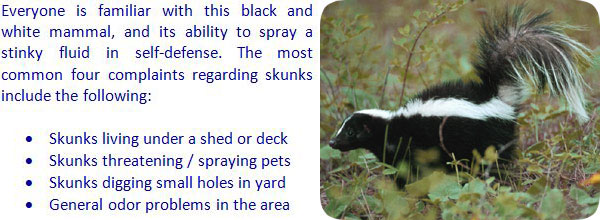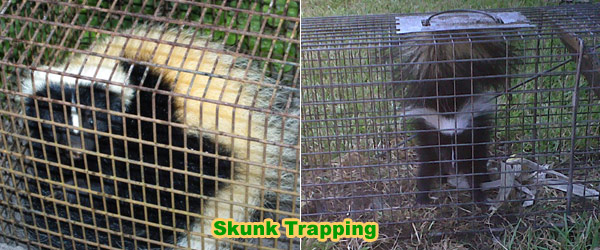- info@wildlifeanimalcontrol.com
Call us for help in your town
Wildlife Control Education
How to Catch a Skunk

Need skunk removal in your hometown? We service over 500 USA locations! Click here to hire us in your town and check prices - updated for year 2020.
Catching a Skunk
Check your local laws and regulations about catching a live skunk. If it is illegal, hire a professional trapper to do the job.
Skunks are usually the size of a house cat. The best kind of trap to get is one that is small enough to make it difficult for the skunk to fully raise its tail, but large enough for the skunk to be comfortable. The cage should also be small enough so they cannot turn around.
To find an appropriate trap, call your local animal control or trapping service to find out what kind they recommend and where to get one. The most used kind of trap is one with a spring loaded door that releases a mechanism with the skunk’s weight after it walks over the door.
See if the trap you get has any kind of cover with it. If skunks cannot see you, they are less likely to spray. If it does not come with a cover, use old blankets or towels to cover the cage before you have caught one. Leave enough fabric folded over the top so you can drop it down in the front of the cage once you have trapped the skunk.

Baits to use
Since skunks are opportunistic omnivores, they will eat just about everything. Some people like to use cat food, fish, and chicken; however, if you have outdoor neighborhood cats, these things may attract them. If you are worried about catching the wrong animal, try more mild smelling bait like apple slices, bread lightly coated with peanut butter, or mayonnaise.
Marshmallows are also great. Read more about what bait catches skunks on this page.
Where to set the trap
When deciding where you set your trap, you need to look for skunk tracks. Follow them and see if you can locate their burrow during the day. Since they are nocturnal, they will be asleep and are not likely to leave the confines of their cozy den.
If you do find the den, set the trap outside the entrance. Place your choice of bait, cover the top and sides of the trap with the cover of your choice, and go back to your house. Check the trap the next morning to see if you have caught a skunk.
Removing the skunk
If you find that you have caught a skunk, drop the last bit of blanket, towel, or tarp over the entrance to the trap. Moving slowly and cautiously, pick up the trap and take it to your vehicle. The best kind of vehicle to use is a pickup truck. There is no guarantee that the skunk will not spray, and having it in an enclosed vehicle would be very unpleasant.
There are two different ways to remove the skunk. Relocation is one of them. Take it far away from your home and release it in a habitat it will like. A place with a lot of ground cover, trees, and places to burrow is ideal. There should also be a source of water nearby to encourage the skunk to stay there.
You can also call animal control and have them come out to pick up the skunk. This will result in the skunk being euthanized since they are known carriers of rabies and other diseases. Relocation of the skunk is ideal.
More in-detail how-to skunk removal articles:
Information about skunk trapping - analysis and methods for how to trap.
Information about how to kill a skunk - with fumigants or poison.
Information about how to keep skunks away - prevention techniques.
Information about skunk repellent - does it work?
Facts about Skunks
We are all familiar with skunks. Nearly every person in North America has come across the foul odor of their spray. The spray is effective at keeping predators at bay and they can shoot it up to 15 feet. It not only smells bad initially, but is oily and very difficult to get rid of. Tomato juice and ketchup are the recommended methods
Skunks are found almost exclusively in the United States. Their habitat stretches across the entire country. They live in burrows they have taken from other animals as well as hollow trees and logs. While there are many different types of skunk, they are all black and white and easily identifiable.
Skunks are omnivores and very opportunistic eaters. They love eggs, snakes, roots, berries, small mammals, and plants. They also raid garbage cans for anything they can. If you have a skunk in your area, make sure your lids are firmly attached and secured.
This site is intended to provide skunk education and information about how to catch a skunk, so that you can make an informed decision
if you need to deal with a skunk problem. This site provides many skunk control articles and strategies, if
you wish to attempt to solve the problem yourself. If you are unable to do so, which is likely with many
cases of skunk removal, please go to the home page and click the USA map, where I have wildlife removal experts
listed in over 500 cites and towns, who can properly help you with your nuisance skunk.

















